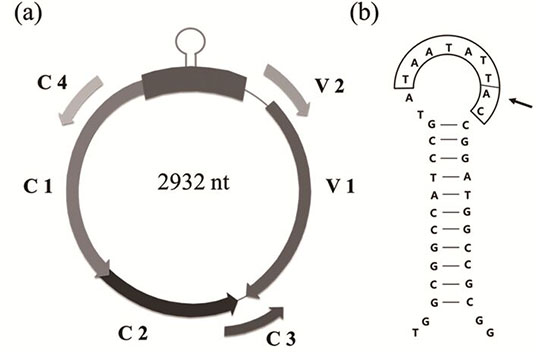分享到
Identification and Characterization of a Novel Geminivirus with Monopartite Genome Infecting Apple Trees
Recently, the cooperation between the Institute of Plant Protection of CAAS and the Institute for Sustainable Plant Protection of Italian National Research Council has yielded a progress in geminivirus research. Researchers identified a novel geminivirus from apple trees using next generation sequencing (NGS). The related research results have been published online in Journal of General Virology on May 1, 2015.
Geminiviruses are economically important and have caused destructive diseases in many herbaceous crops all over the world. Although more than 200 geminiviruses have been reported, only very limited geminiviruses were isolated from woody plants, especially from fruit trees. Therefore, the researchers tried to use the new technology of NGS to explore possible existence of geminiviruses in apple trees. As expected, a novel geminivirus, provisionally named as Apple geminivirus (AGV), was identified from an apple tree grown in China. AGV is a new virus with a monopartite DNA genome with size of 2932 nt. In addition, AGV is infectious in several herbaceous plants (Nicotiana bethamiana, N. glutinosa and Solanum lycopersicum). A survey on 165 apple trees grown in four Chinese provinces showed a prevalence of 7.2% for AGV, confirming its presence in several cultivars and apple production areas in China.

Figure 1 (a) Schematic representation of the circular DNA genome of AGV;
(b) The stem-loop in the intergenic region.
Geminiviruses are economically important and have caused destructive diseases in many herbaceous crops all over the world. Although more than 200 geminiviruses have been reported, only very limited geminiviruses were isolated from woody plants, especially from fruit trees. Therefore, the researchers tried to use the new technology of NGS to explore possible existence of geminiviruses in apple trees. As expected, a novel geminivirus, provisionally named as Apple geminivirus (AGV), was identified from an apple tree grown in China. AGV is a new virus with a monopartite DNA genome with size of 2932 nt. In addition, AGV is infectious in several herbaceous plants (Nicotiana bethamiana, N. glutinosa and Solanum lycopersicum). A survey on 165 apple trees grown in four Chinese provinces showed a prevalence of 7.2% for AGV, confirming its presence in several cultivars and apple production areas in China.

Figure 1 (a) Schematic representation of the circular DNA genome of AGV;
(b) The stem-loop in the intergenic region.
The discovery of AGV suggests that geminiviruses have much more infectivity than we expected before, and also further opened the door to the study of geminiviruses in woody crops. This research supports the use of NGS as a powerful technology for identifying new viruses, especially in woody plants.
This work was supported by grants from the Earmarked Fund for China Agriculture Research System, the Special Fund for Agro-scientific Research in the Public Interest, and the National Natural Science Foundation of China (NSFC).
For more information, please visit:
http://jgv.sgmjournals.org/content/early/2015/05/01/vir.0.000173.abstract
This work was supported by grants from the Earmarked Fund for China Agriculture Research System, the Special Fund for Agro-scientific Research in the Public Interest, and the National Natural Science Foundation of China (NSFC).
For more information, please visit:
http://jgv.sgmjournals.org/content/early/2015/05/01/vir.0.000173.abstract
Latest News
-
 Apr 18, 2024Opening Ceremony of the Training Workshop on Wheat Head Scab Resistance Breeding and Pest Control in Africa Held in CAAS
Apr 18, 2024Opening Ceremony of the Training Workshop on Wheat Head Scab Resistance Breeding and Pest Control in Africa Held in CAAS -
 Apr 03, 2024IPPCAAS Co-organized the Training Workshop on Management and Application of Biopesticides in Nepal
Apr 03, 2024IPPCAAS Co-organized the Training Workshop on Management and Application of Biopesticides in Nepal -
 Mar 28, 2024Delegation from the School of Agriculture and Food Science of University College Dublin, Ireland Visit to IAS, CAAS
Mar 28, 2024Delegation from the School of Agriculture and Food Science of University College Dublin, Ireland Visit to IAS, CAAS -
 Mar 25, 2024Director of World Food Prize Foundation visited GSCAAS
Mar 25, 2024Director of World Food Prize Foundation visited GSCAAS -
 Mar 20, 2024Institute of Crop Sciences (ICS) and Syngenta Group Global Seeds Advance Collaborative Research in the Seed Industry
Mar 20, 2024Institute of Crop Sciences (ICS) and Syngenta Group Global Seeds Advance Collaborative Research in the Seed Industry
